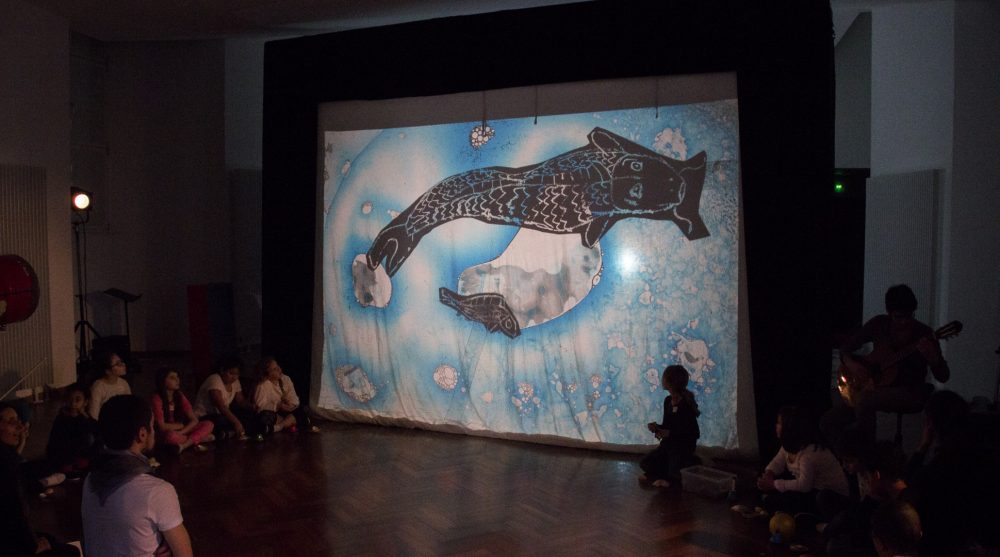Summary
Musical creation and shadow theatre around Haikus
Project Description
To build a visual and musical show inspired by shadow techniques. These were passed on to the children and students by the visual artists from the ESAT Evasion, Sélestat. Starting with 3 haikus, imagine shapes, images, realise them, manipulate them, set them moving on a screen. Develop sound worlds written and improvised in connection with the images
The project proposes to make a visual and musical experience that combines musical gesture, body movement, shadows and the visible, coercion and flexibility. Project led by Emmanuelle Zanfonato, director and Abril Padilla, composer and performed by the teacher, students and pupils.
Duration: 4 x 15 to 20 min
Age: from age 8
Key words creativity and entrepreneurship: Enthusiasm, Transformation in production, Development of ideas and solutions, Imagination, Interaction with the environment
Description
Introduction
Contents
Haikus, some thoughts
Haiku do not merely describe or illustrate, they evoke, suggest and translate most
often a sensation, an emotion, a transient feeling and must be read in a single breath. They require some detachment to be written. The idea of blurring is important.
The visual
The visual aspect must capture the evanescent character of one or more selected or written haikus (link writing a haiku) by students and build a show, a journey of as many “living pictures” as Haikus by exploring graphic techniques and shadows using overhead projectors.
Imagine and construct images, “puppets with shadows”, realized and manipulated by the children.
Put these shapes and the body in motion in the images.
Find the material for a show in the improvisation of the musical with images, the improvisation of the visual in the musical, all in relation to what is proposed by the haiku selected by the teacher or the students. The haikus can be written by the students.
The musical
From an orchestration defined by the chosen Haikus, propose different ways of approaching improvisation by invoking sensations, images and movements invented for the occasion.
Offer children a set of instruments, sound bodies, and Haikus texts to explore, to appropriate technology and open their imaginations through a rich variety of musical sensations.
If children play an instrument or are part of a choir, integrate their specialisation.
The Body in motion
The focus will be on the bodywork. Warm-ups will be necessary.
In connection with the contents of the Haikus, improvisations in space will mix the shadows of the bodies and manipulate objects in shadow. Questions of rhythm (slowness and rapidity), concentration, precision, accuracy will be addressed.
Step 1 Shadows # 1 Synchronize
Duration: 15 to 20 min
Age: from age 8
Competencies
Students are able to:
- follow the image closely, its rhythm, tempo, intent;
- be open to reacting to an image, through sound and music.
Description: The children behind the screen (those who appear in the shadows) are the leaders. The musicians, who are the other side of the screen, react.
Equipment: flute, marimba and various manufactured individual blades.
Contribute:
This scene proposes a sequence related to the density of the visual, from very full to the empty.
This determines the timing of its execution.
Plastic artists, manipulators, players, musicians:
– The players project shadows: differing by the movement of their images projected on the screen (for example by kicking, jumping, pushing with the hands).
– Image manipulators use the overhead projector (with a small tweezer): follow the player’s shadow by synchronizing the movements of the image with the movements of the player’s shadow (eg kicking, shifting the Image to give the impression that the shadow leaves).
– Musicians: play by following the shadow movements (for example, a percussion strike with each kick).
– Child spectators: can then comment on the scene and offer suggestions to make it evolve.
Keywords and combinations with other modules: imagination, autonomy, synchronization, collective musical creation
Step 2 Shadows No. 2 Play with the visible and the invisible
Duration: 15 to 20 min
Age: from age 8
Competencies
Students are able to:
- seek to amplify in sounds and music, the “unseen” events but are yet part of the situation, in the image;
- be autonomous in relation to an image that takes place in time.
Description: Synchronization as in Shadows # 1 but with the addition of a continuous background: “The River “
The River
Materials:
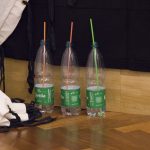
- Plastic bags of different textures played in various ways (wrinkled, pulled, rubbed, inflated, etc.)
- Plastic bottles + straws (water balls = plastic bottles filled with water in which the students blow with straws)
Emerging Sounds:
- The fish’s voice (look for an imaginary voice for each fish)
Plastic artists, manipulators, players, musicians:
On the overhead projector, estimate the length of the sequence and realize the landscape “river” necessary, master the rhythm of the unfolding landscape, make the puppets live according to the story. Feel the timing of the appearance of the images to make room for the sound image. The same for the wire puppets manipulated near the screen, linking the gesture to the situation.
Step 3 Shadows 3 Follow and be autonomous
Duration: 15 to 20 min
Age: from age 8
Competencies
Students are able to:
- play in contact with the image under discrete conduction;
- be autonomous while following a leader.
Materials:
For music: wah-wah bells, balloons boxes
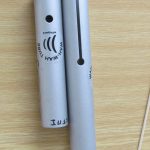
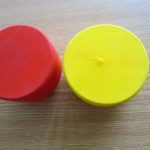
Description: Decide in advance of an order for the succession of different moments – different modes of play, instruments, play skills, etc.
The follow-up of the image with music is not in absolute synchronization with the image but in the transmission of an idea, of a general sensation in music.
Plastic artists, manipulators:
Semolina on the overhead screen drawn with fingers. Make black shapes appear close to the sound world, or a straight sound that ends in arabesque (stylized flowers). Difficulties: drawing upside down on the overhead projector for an image to be in place, avoiding showing the drawing hand.
Step 4 Shadows No. 4 Develop your creativity based on a work from the repertoire
Duration: 15 to 20 min
Age: from age 8
Competencies
The pupils are able to:
- listen to pre-existing music and be able to associate it with other possible sound worlds, according to an image that the group has agreed (link here to an image);
- develop their creativity by taking account of a musical work in the repertoire.
Description: even proposed direction in Shadows # 3 but on a musical piece from the repertoire.
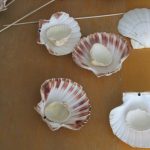
Sound bodies: shells on the wooden floor.
The movement of the image is inspired by the music in the phrasing, tempi, rhythms, etc.
Plastic artists, manipulators:
Manipulation of coloured fringes in front of the light according to the sound and static swimming of the puppet that requires precision in play. Landscape atmosphere gives way to music while being visually alive.
Competencies
The pupils are able to:
- be open to reacting to an image, through sound and music;
- develop their creativity by taking account of a musical work in the repertoire;
- be autonomous while following a leader;
- be autonomous in relation to an image that takes place in time.
Materials
According to the proposals: music instruments or sound bodies
Module Overview
|
